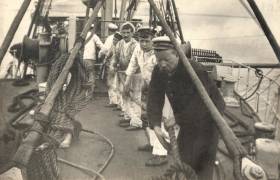Displaying items by tag: Royal Irish Academy
Touring Exhibition: Safety at Sea through War and Upheaval: Irish Lights 1911-1923
#Exhibition - The Commissioners of Irish Lights and the Royal Irish Academy continues to tour an exhibition around our coastline that captures the history of Irish Lights.
Having first exhibited last year in Cobh as Afloat reported on the next venue will be Wexford at the town’s County Office HQ and is scheduled from 23 January-5 March. The location is at Carricklawn (close to Wexford General Hospital) on the (R769) road that leads west out of the town.
The history of the island of Ireland itself, its ever-changing coasts and shorelines, and the history of the people who lived along our island’s seaboard. Through the nineteenth century the number of Ireland’s lighthouses increased from fourteen to seventy-four, with eleven lightships placed around the east and south coasts.
The exhibition explores how Irish Lights, with its origins in the late-eighteenth century, and coming of age in the certainties of the nineteenth, faced the challenges of global and national uncertainty in the early twentieth century. Precisely, the exhibition details Irish Lights’ history between 1911 and 1923.
Also explored in the exhibition through these years are the incredible events, such as; the Easter Rising of 1916, the Anglo-Irish War of 1919–1921 and the Anglo-Irish Treaty.
What emerges is a never-before told story of devotion to duty, scientific, engineering and physical endeavour, world war, revolution and change.
It is also a deeply personal story of those who worked with and built up Irish Lights. Those who devoted their lives to protecting the coastline for the safety of all which remains to the present day and by keeping abreast of future technological developments.
National Heritage Week: Maritime Lecture Programme
#MARINE HERITAGE – Up and down the country, events are been held for the annual National Heritage Week including a series of maritime lectures as previously reported on Afloat.ie
Below is a full detailed description of the varied topics of the lecture programme which is to be held in the Dun Laoghaire Club, Eblana Avenue (off Marine Road) on the final day (Sunday 26th August) of the heritage week.
12 noon The 'Kowloon Bridge' and her sisters – by Garda Diver Peter Brady.
1.15 pm A West of Ireland view of the Battle of the Atlantic – by Dr. Michael Kennedy, Royal Irish Academy.
3.00 pm Early navigation in Ireland / maritime archaeology of Sligo harbour and bay.- by Auriel Robinson DAHG.
4.15 pm Captain Bligh and Dublin Bay- speaker, Terry Cummins of the Irish Naval Association.
6.00 pm The greatest naval catastrophe in England's history-concealed throughout history by Elizabethan propaganda historiography.
This lecture is to be presented by special guest speaker; Dr. Luis Gorrochategui Santos – who is visiting Ireland especially for the heritage week lectures organised by the Maritime Institute of Ireland (M.I.I.) which runs the National Maritime Museum of Ireland.
For further information about the day's lecture contact Barney Yourell on 087 9007466
Admission is free, noting there is a recommended donation of €10

























































